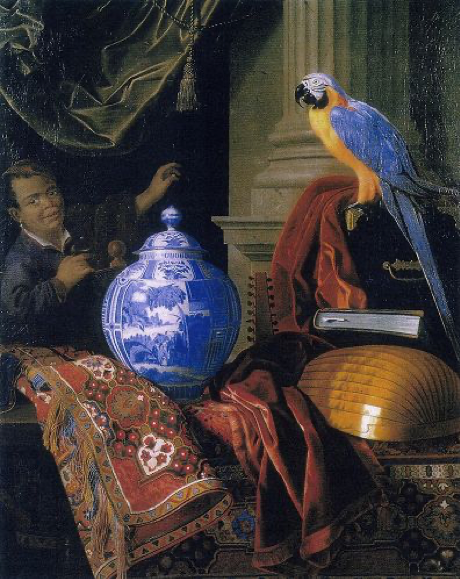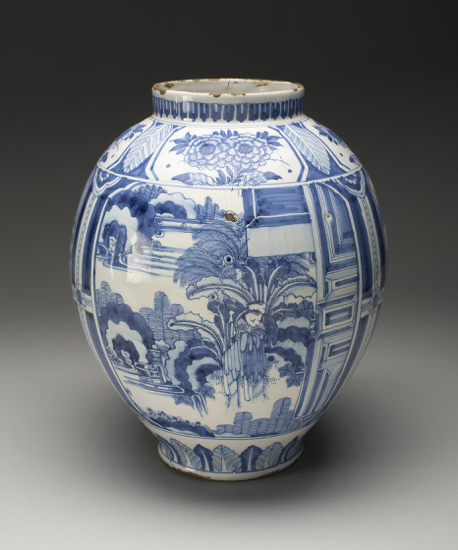Dutch Delft baluster-shaped vase
A Dutch Delft baluster-shaped vase with flower and animal decoration, 18th century, around 1710, Delft, Holland.
Dimensions: 66 cm. height.
De Metaale Pot factory (1670-1775), Lambertus van Eenhoorn (1651-1721)
Reference: 10023
A rare and historically important Delft earthenware double-gourd-shaped vase with Japanese influenced decoration, around 1660-1680, Delft, Holland.
Blue and white
Dimensions: 37,2 cm height.
 Secure payment
Secure payment
100% secure payment
 Worldwide shipping
Worldwide shipping
Fast delivery
 Free shipping in EU
Free shipping in EU
On all orders
 Professional packaging
Professional packaging
Professional order packaging
This rare and historically important Delft earthenware vase has a so called ‘double-gourd’ shape, also known as a ‘húlu (葫芦/葫蘆)’ or ‘bottle gourd (calabash)’. The shape has its origin in ancient Chinese culture. Nevertheless, this vase is copied (or inspired) by the Delft potters quickly after the first lager import arrivals of Japanese (Arita) porcelain in The Netherlands. We can see this type of decoration on the pottery from 1660 on until 1680. All of these Japanese style Delft objects are painted in a soft blue glaze just like the underglaze Arita porcelain examples. They also match closely to the original Japanese decorations. Typical for this Japanese style decorations are the simply painted oriental figures with big round heads, the featherlike pine trees and palmtrees. The symmetrical thick ‘pillars’ that divide the vase in different panels is on the other hand a charactaristic from the Chinese Wanli period. These elements can also been seen on the vase described. This vase has three different panels divided by dotted cruciform ‘pillars’ against a bleu ground. The 'shoulder part' of the vase has these 'pillars' filled with stiff leaf motifs, that also divide the shoulder in three different panels. The neck has beautiful leaf motifs as well.
Condition: Very good, with two small professional restorations (one vertical to the neck/neck rim and one of two-centimeter glaze loss of the belly.)
Provenance:
-The Dr. Günter Grethe Collection (Dr. Günter Grethe (1919-2005) was a retired notary public from Hamburg, with an impressive collection representing fifty years of connoisseurship and over 150 quality Dutch Delftware objects from the 17th and early 18th century).
-R.D. Aaronson, 2004.
Reference:
This exact vase is published with a description and image in" “D. and R. Aaronson, ‘Dutch Delftware The Dr. Günter Grethe Collection’, 2004, page 11”.
Comparable examples:
-A Delft ovoid jar with the similar decoration appears on a painting by Cornelis de Man (1621-1706), who lived in the Delft city himself (Reference: Frankfurt Historisches Museum CC-BY-SA 4.0: HMF).
-A Delft ovoid jar with the similar decoration is illustrated by C.J.A. Jörg in: ‘Oosters porselein, Delft aardewerk - Wisselwerkingen, 1983’, page 128-129.
-A Delft ovoid jar with the similar decoration is in the possession of The Art Institute of Chicago Museum (Reference Number 1944.289).



Still life with black boy and parrot by Similar Delftware in The Art Institute of Chicago
Cornelis de Man (1621-1706). Source: The Art Institute of Chicago
Source: RKD Research
__________________________________________________________________________________________
Japanese influence on early Delftwares
By T.M. (Toussaint) Verkoulen
During the prominent era of tin-glaze pottery in the Netherlands, spanning from 1640 to 1740, massive eastern influences on the decoration style occurred because of several economic, political and cultural reasons. We more often see the influence from Chinese porcelain on Delft pottery (as I wrote in “Delft answers: the start of copying China.”). Although, In the period from 1660 to 1680 early traces of Japanese influence on Delft earthenware decoration can first been seen.
The first arrival of larger orders Japanese (Arita) porcelain arrived around 1660 in the Netherlands. The Dutch sought Japanese porcelain as an alternative source when the porcelain trade with China encountered difficulties around 1645. The civil wars in southern China led to the destruction of many porcelain kilns. From 1650 on, the Dutch merchants made attempts to reorganize and to increase the production capacity of existing kilns in Arita because the Japanese could not match the production quantities of porcelain that the East India Companies were used obtaining in China. The majority of exported Arita porcelain pieces did not yet exhibit a distinct Japanese style, as their decorations closely mimicked those found on Chinese export porcelain. But in the years after 1660 the Japanese craftsman developed their own style on porcelain: The Chinese repertoire of decorative motives was greatly reduced and the Japanese wares got little detail and hardly any noticeable sense of proportion or coherence (in compare to Chinese porcelain).
According to Drs. Frits Scholten, studies have confirmed that at least certain Delftware manufacturers quickly adopted the style of early blue and white Arita export ware. An advantage for Delft potters was that the Japanese style was easier to copy than the paintings on Chinese porcelain, due to its relatively simple style. These Delft responses in 1660 on the Japanese imports can be marked faster than their response on the shortage in Chinese porcelain from 1650 on: by that time the Delft potters were busy with establishing themselves and changes to the clay and glazing Process. By 1665 there were already more than 20 pottery factories in Delft, which mainly produced in massive numbers in order to fill the Ming-Qing transition gap left by the Chinese; but clearly not only influenced by China but also Japan. Most of the Delftware products with Japanese influences were traditionally ascribed to be produced in Frankfurt kilns. However ‘Delftware products’ have indeed also been made in England (English delftware: Britsol, London and Liverpool) and Frankfurt, this attribution was a wrong interpretation from late 20th century writers.
Source: D. and R. Aaronson, ”Dutch Delftware The Dr. Günter Grethe Collection”, 2004.
F. Scholten, “The influence of early Japanese export porcelain on Dutch Delftware, 1660-1680”, 1990.
T. Giehler “The Ceramics of Eurasia How export porcelain has shaped a globalized world”, 2019.